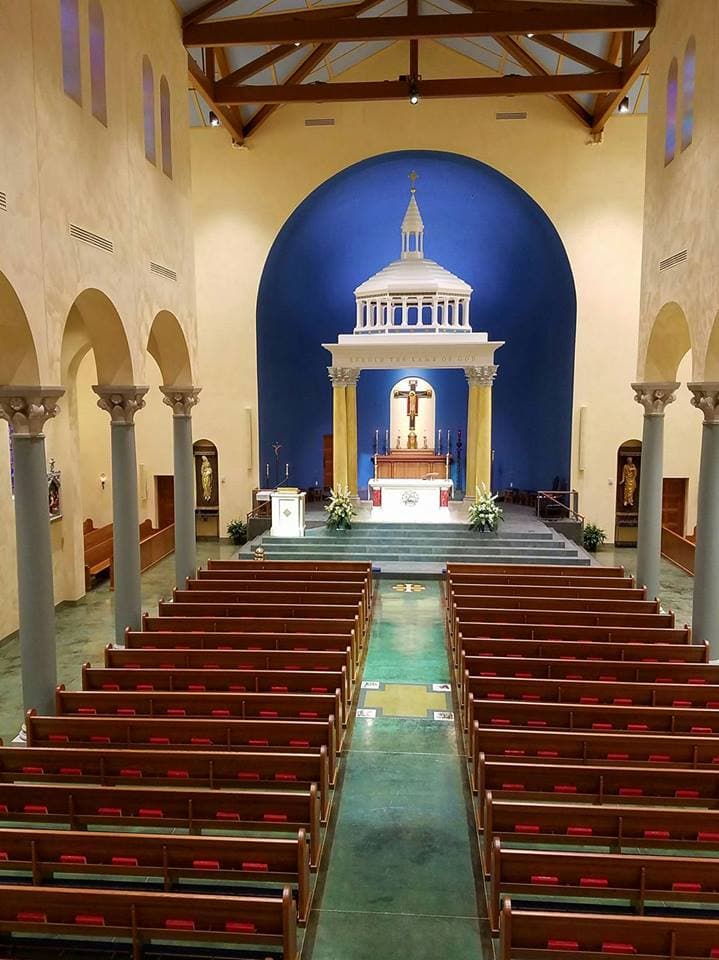Sixty years ago a group of Catholics in Greenville, South Carolina started to meet in a little white clapboard house to celebrate Mass. They soon built a school and began worshipping in a temporary, warehouse-type building.
Finally, last weekend the Bishop of Charleston consecrated our beautiful new church. Built in the Romanesque style, the church makes a clear statement about the beauty, truth and goodness of our two-thousand-year Catholic traditions in art, architecture, music and liturgy.
Many people (Catholics included) here in America’s Bible belt have never seen a church like this.
With a nineteenth-century hand-painted crucifix in the style of thirteenth-century master Duccio, with a collection of 47 stained-glass windows salvaged from a church in Massachusetts, and with other salvaged artwork as well as commissions by contemporary artists and designers, everyone’s first words about the church are, “It’s beautiful!”
Indeed. Fyodor Dostoevsky wrote, “Beauty will save the world.” What did he mean by that? Why did the people of a small parish in South Carolina take the trouble and go to the expense of building a beautiful church?
We did so for several reasons.
First, we built this kind of church because the people asked for it. I have always been bemused by the modernist ideology that the brutalist church architecture of the last sixty years was somehow “of the people, for the people and by the people.”
It was not. It was for the ideologically driven architects and liturgists. The people never wanted churches that looked like ice-cream cones that had fallen from the sky.
I travel to many parishes and have made a point of asking the people if they love their church that resembles a cross between a parking garage and a circus tent. They say polite things like, “I like the padded pews.” or “The sound system is really excellent.”
No one has ever said, “It is beautiful.”
At my first building committee meeting I asked my people if they wanted a round, suburban style modern church. They practically yelled their rejection and pleaded for a traditionally styled church.
It has been said that the Gospel is never good news unless it is subversive.
Second, we built a church that is beautiful because in this utilitarian, egalitarian and cost effective age to create something truly beautiful and lasting is subversive. Going to extra effort to do something beautiful for God presents a witness that undermines the cost-effective and efficient yet brutal values of the world.
Building a beautiful church says to the surrounding community, “Here is Catholicism. It stands for something greater than mere cheapness.”
In saying that, we have also shown that a beautiful church need not be terribly expensive. Our parish is small—with only five hundred households. We are situated in the poorest part of town with dire socio-economic conditions. We have proved that by using modern building materials and techniques a traditionally styled church is affordable. True beauty need not be extravagant.
Third, we have built a church that is beautiful because a Catholic church is not an auditorium. It is not merely a fellowship hall where the family meal is celebrated. It is also the temple of God where the sacramental presence of God is reserved, celebrated and worshipped.
If the church is a temple, then it should be a fitting dwelling place for God. While it is true that Jesus was born in a stable, he didn’t stay there. He came down so that we might go up, and a beautiful church reminds us of our ultimate destiny and our heavenly calling.
Fourth, we built a church that is beautiful for theological reasons. Put simply, God is not only good and true, he is beautiful. Furthermore, He is the source and foundation of all that is beautiful.
When we apprehend the beautiful we experience a mystical encounter with the divine. Through our senses we connect with beauty in a way beyond words. As we do we connect with the transcendent. This experience is a vital part of our humanity.
The apprehension of beauty connects us also with goodness and truth, for goodness, truth and beauty are one of God’s “little holy trinities.” Beauty therefore illuminates the heart, inspires the mind and opens the soul to the eternal.
In Catholic tradition, to enter the church is to return to Eden and get a glimpse of glory. It is the threshold of heaven and the doorway to another world. This is how beauty will save the world—by reminding us worldlings that there is more to heaven and earth than they had dreamed.
I am extremely proud that the ordinary people of my very ordinary parish not only opened their minds and hearts to these principles, but they also opened their hearts and opened their wallets to “do something beautiful for God.”
[For a virtual look-round of Our Lady of the Rosary in Greenville, go to the parish picture gallery]






